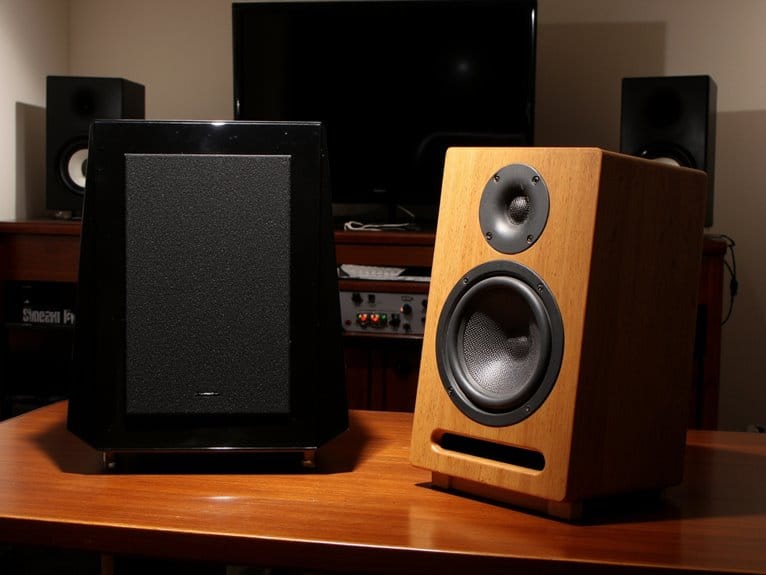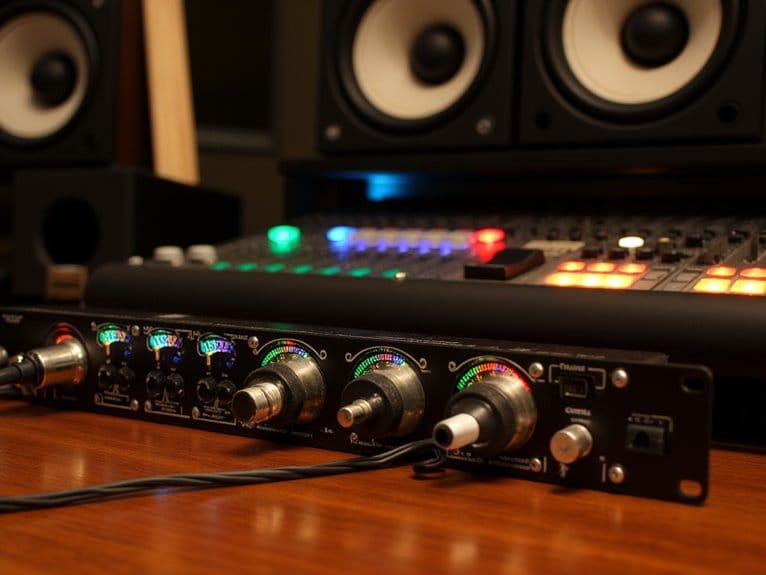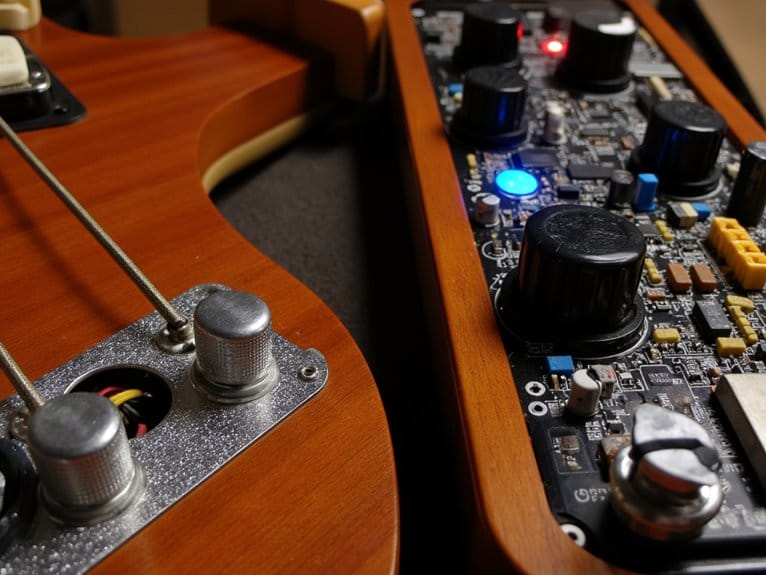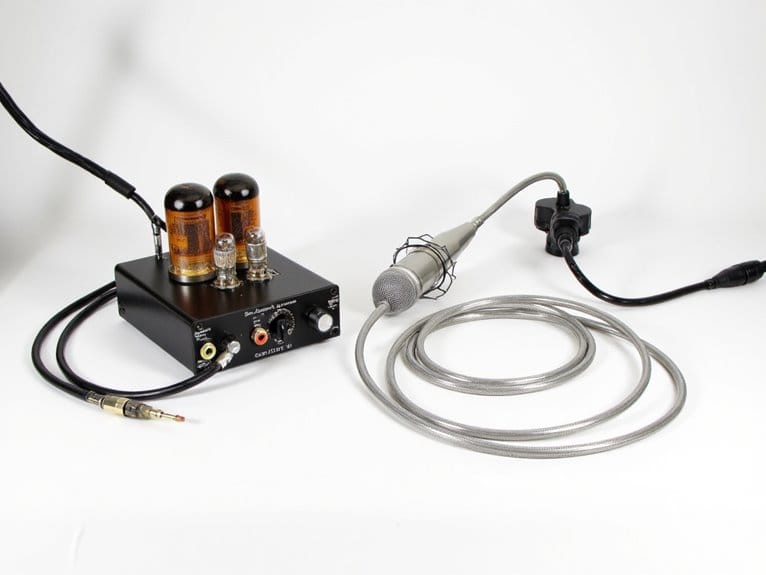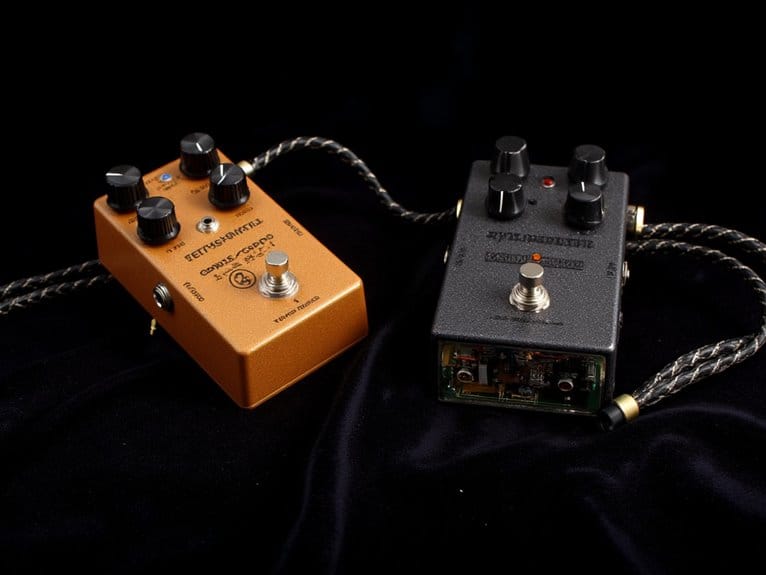Reference Monitors Vs Mixing Monitors: Understanding the Difference
You’ll find that reference monitors deliver ruthlessly flat frequency response from 40-45 Hz to 20 kHz, exposing every uncolored detail for critical mixing decisions, while mixing monitors incorporate subtle frequency adjustments that reduce ear fatigue during those marathon studio sessions. Reference monitors demand precise room treatment and placement calculations, whereas mixing monitors offer more forgiving flexibility in less-than-ideal acoustic environments. Understanding these distinctions becomes essential when your budget and studio setup determine which approach will actually deliver the professional results you’re after.
We are supported by our audience. When you purchase through links on our site, we may earn an affiliate commission, at no extra cost for you. Learn more.
Notable Insights
- Reference monitors provide exceptionally flat frequency response for uncolored, accurate sound reproduction during critical mixing decisions.
- Mixing monitors balance accuracy with listening comfort, incorporating subtle frequency adjustments to reduce fatigue during long sessions.
- Reference monitors require precise placement and room treatment, while mixing monitors offer more flexibility in suboptimal environments.
- Both monitor types prioritize sonic accuracy but reference monitors demand stricter acoustic conditions for optimal performance.
- Reference monitors ensure mix translation across playback systems, while mixing monitors focus on natural sound environments.
What Are Reference and Mixing Monitors?
When you’re steering through the world of studio monitors, I’ve found that understanding the distinction between reference and mixing monitors can initially seem confusing, since both serve the fundamental purpose of accurate sound reproduction in professional audio environments.
Reference monitors are specialized speakers engineered with flat frequency response characteristics, designed to reveal uncolored, truthful audio representation without artificial enhancement or frequency manipulation. Their speaker design prioritizes neutrality above all else, enabling you to make mixing decisions based on pure sonic accuracy. These monitors ensure that music translates well across various audio systems including headphones, radios, and larger speakers.
Mixing monitors, while sharing similar accuracy goals, focus specifically on providing natural sound environments where you can judge panning, spatial width, and instrument placement effectively. They excel at helping you achieve proper track levels to enhance the overall impact on your listener.
Both monitor types utilize sophisticated driver configurations and precise acoustic engineering to eliminate coloration that might mislead your critical listening decisions during production workflows.
Frequency Response and Sound Accuracy Differences
How precisely do reference and mixing monitors differ in their frequency response characteristics, and why should these technical distinctions matter for your studio decisions?
Reference monitors maintain an exceptionally flat frequency response across the entire audible spectrum, typically from 40-45 Hz to 20 kHz, without boosting or reducing any frequency range. This neutral approach guarantees your mixes translate accurately across different playback systems.
Mixing monitors, however, often incorporate subtle frequency adjustments, sometimes softening upper mids or enhancing certain bands to reduce listener fatigue during extended sessions. While this makes them more comfortable for long mixing marathons, it can compromise pure accuracy.
Your sound accuracy assessment depends on understanding these differences – reference monitors prioritize transparency for critical decision-making, while mixing monitors balance precision with user comfort, occasionally trading slight neutrality for enhanced workflow sustainability. Professional monitors like those with DSP-driven graphic EQ systems offer room tuning capabilities that can help optimize performance in various acoustic environments. Room treatment plays a significant role in achieving optimal sound quality regardless of which monitor type you choose, as even the most accurate speakers can be compromised by poor acoustic environments.
Room Acoustics and Placement Requirements
Beyond their inherent frequency characteristics, reference and mixing monitors face dramatically different challenges when you’re positioning them within your studio space. I’ve learned through countless room configurations that even the most accurate monitors can sound terrible without proper placement consideration.
Reference monitors typically demand more precise monitor distance calculations—ideally forming that equilateral triangle we’ve all heard about—while mixing monitors offer greater flexibility in less-than-ideal setups.
Here’s what I’ve discovered about critical placement factors:
- Wall proximity matters immensely: Keep monitors either within 10cm of walls with boundary EQ, or maintain 1.5m+ distance.
- Reflective surfaces kill accuracy: Desktop placement without isolation pads creates problematic resonances.
- Room size dictates monitor choice: Under 16sqm requires near-fields; 25-40sqm benefits from mid-field options.
When building your monitoring setup, remember that your choice of audio interface will significantly impact the quality of signal conversion between your DAW and monitors, affecting the accuracy of what you’re hearing during critical mixing decisions.
Monitors Vs Headphones for Audio Production
Even the most perfectly positioned monitors won’t solve every audio production challenge, which is where the age-old debate between monitors and headphones becomes particularly relevant for your daily workflow decisions.
While monitor calibration delivers flatter frequency response and natural stereo imaging through room acoustics, headphones offer superior headphone isolation and consistency that bypasses problematic room treatments entirely.
You’ll find that monitors engage spatial cues your brain naturally processes, creating realistic soundstage perception that headphones struggle to replicate accurately.
However, headphones excel in portable scenarios and shared spaces where sound leakage matters most.
I’ve learned that switching between both tools compensates for each system’s limitations, though monitors typically cause less ear fatigue during extended mixing sessions.
Benefits for Professional Mixing and Production
While the monitor versus headphones debate often focuses on convenience factors, the real conversation should center on how reference monitors fundamentally transform your mixing capabilities through their superior accuracy and professional-grade performance characteristics.
I’ve found that monitors deliver exceptional audio fidelity through flat frequency responses that reveal your mix’s true spectral balance, eliminating the guesswork that plagues headphone-based mixing techniques. The spatial imaging accuracy becomes particularly vital when you’re positioning instruments across the stereo field.
Here’s what makes monitors essential for professional work:
- Extended session capability – reduced fatigue lets you maintain focus during critical mixing decisions
- Industry standard workflow – consistent reference point that translates across professional environments
- Room acoustic integration – identifies potential issues while enabling informed mix corrections
This combination creates mixes that translate reliably across diverse playback systems. Professional monitors with balanced XLR inputs ensure minimal signal degradation, maintaining the pristine audio quality necessary for accurate mixing decisions. Achieving 24-bit/192kHz resolution through high-quality audio interfaces further enhances the accuracy of your monitoring chain by capturing every nuance of your mix with crystal clear detail. Just as student musicians benefit from lightweight configurations around 5 pounds to reduce strain during extended practice sessions, professional audio engineers experience similar advantages with properly positioned monitors that minimize physical fatigue during lengthy mixing sessions.
Common Challenges and Technical Limitations
Reference monitors aren’t without their technical hurdles, and I’ve learned through countless studio sessions that understanding these limitations proves just as important as appreciating their strengths.
You’ll encounter design constraints that force compromises between bass extension and transient response, particularly with ported versus sealed cabinet configurations. Ported designs deliver deeper low-end but introduce group delay around 40-60 Hz, while smaller monitors simply can’t reproduce authoritative bass regardless of design.
Monitor cabinet design forces inevitable compromises between deep bass extension and precise transient response, with size limitations affecting low-frequency reproduction regardless of configuration.
Room interactions create another layer of complexity, requiring strategic acoustic treatment and careful placement to minimize reflections that color your mix decisions.
Even premium monitors struggle with crossover design trade-offs, where driver overlap regions can create frequency irregularities that affect accuracy, making your mixing environment as significant as the monitors themselves.
Choosing the Right Monitor Type for Your Studio
When you’re selecting between reference and mixing monitors for your studio, I’ve found that your budget constraints and available space will greatly influence which type best suits your specific needs, since high-end reference monitors often require substantial financial investment alongside dedicated room treatment.
Your room’s acoustic characteristics, including dimensions, reflective surfaces, and ambient noise levels, play an essential role in determining whether reference monitors will deliver their intended flat response or if mixing monitors might better complement your existing environment.
I always recommend evaluating both your physical workspace limitations and acoustic treatment budget simultaneously, as even the most expensive reference monitors can underperform in poorly treated rooms, while well-chosen mixing monitors in properly acoustically managed spaces often yield superior results.
Additionally, incorporating a quality monitor controller into your setup ensures pristine signal integrity and provides essential features like source switching and volume management that enhance your monitoring workflow regardless of which speaker type you choose.
For budget-conscious producers working in smaller spaces, affordable studio monitors with flat frequency response can deliver professional-quality sound that matches higher-end options for mixing and production work.
Budget and Space Considerations
Before diving into the technical aspects of monitor selection, I need to address the elephant in the room that many producers face: your wallet and workspace will likely dictate your monitoring choices more than any frequency response chart ever will.
Budget constraints force tough decisions between monitor quality and essential accessories like audio interfaces or acoustic treatment.
Space optimization becomes critical when you’re working in bedrooms or cramped studios where proper monitor placement seems impossible.
Here’s what I’ve learned about balancing these realities:
- Start with quality headphones if your budget’s under $500 – they’ll outperform cheap monitors in untreated spaces.
- Prioritize smaller reference monitors over larger mixing monitors when space is limited.
- Plan phased upgrades rather than compromising on everything at once.
Your constraints aren’t limitations; they’re parameters for smart decision-making. When pairing your monitor choice with recording equipment, consider that many affordable audio interfaces under $200 deliver professional-grade preamps that complement both reference and mixing monitors effectively.
Room Acoustics Requirements
Though many producers obsess over frequency response charts and driver specifications, I’ve discovered that your room’s acoustics will dramatically reshape any monitor’s sound before it reaches your ears, making acoustic compatibility the most critical factor in monitor selection.
| Monitor Type | Room Treatment Needs | Acoustic Tolerance |
|---|---|---|
| Reference | Extensive absorption, bass traps | Low – requires precise acoustics |
| Mixing | Moderate room treatment | Medium – more forgiving |
| Near-field | Basic acoustic panels | High – adapts to various spaces |
Reference monitors demand meticulous room treatment, including strategic sound diffusion and absorption panels, because their uncolored response reveals every acoustic flaw. Mixing monitors offer greater flexibility in untreated spaces, while their built-in voicing compensates for common room issues, making them practical choices for home studios with limited acoustic investment.
Frequently Asked Questions
Can I Damage Reference Monitors by Playing Music Too Loudly for Extended Periods?
Yes, you’ll risk speaker damage from loud volume over extended periods. Excessive loudness can overheat voice coils, damage cones and tweeters, and cause permanent distortion that compromises your reference monitors’ accuracy.
Do Wireless Reference Monitors Have Latency Issues That Affect Real-Time Monitoring Accuracy?
Yes, you’ll experience latency impact with wireless technology in reference monitors, typically 5-15ms delays. This affects real-time monitoring accuracy by disrupting timing perception and spatial positioning, though ultra-low latency models minimize these issues considerably.
How Often Should Reference Monitors Be Recalibrated for Optimal Performance?
You should recalibrate reference monitors every 6-12 months for ideal performance. Calibration frequency depends on performance factors like usage intensity, environmental conditions, and component aging that affect your monitors’ accuracy over time.
Are There Specific Brands That Music Industry Professionals Consistently Prefer Over Others?
You’ll find Genelec, PMC, and Adam Audio are consistently popular brands among professionals. These industry standards dominate high-end studios, while Yamaha HS series and KRK remain trusted mid-range choices for their reliability and accuracy.
What’s the Typical Lifespan of Reference Monitors Before They Need Replacement?
You’ll typically get 10-15 years from quality reference monitors with proper monitor maintenance. Their lifespan longevity depends on usage patterns, environmental conditions, and care—moderate volumes and regular cleaning greatly extend their functional life.
On a final note
You’ll find that choosing between reference and mixing monitors ultimately depends on your specific workflow, budget constraints, and studio environment. While I’ve learned that reference monitors excel at revealing mix flaws with surgical precision, mixing monitors often provide the musical context you need for creative decisions. Don’t overthink it—trust your ears, test both types if possible, and remember that even seasoned engineers sometimes debate which approach works best for their particular setup.

